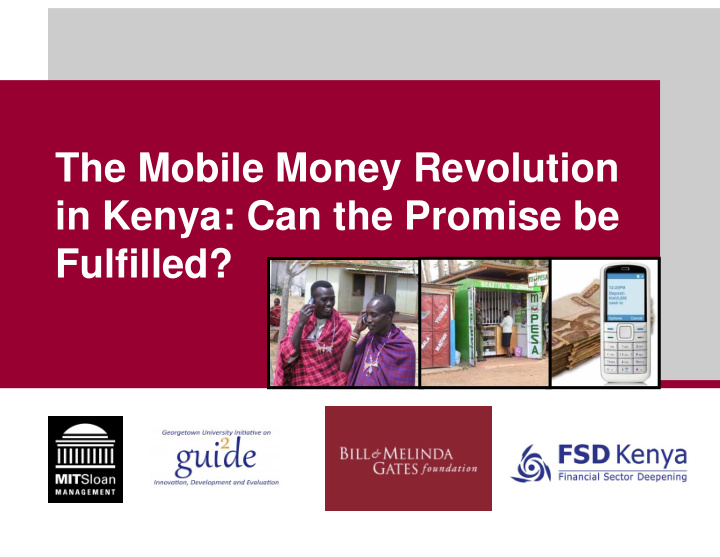



The Mobile Money Revolution in Kenya: Can the Promise be Fulfilled?
An Efficient Financial System Decades of research: efficient financial systems are key to • economic growth and poverty reduction One major reason financial markets in the developing world lack • efficiency is high transaction costs – Traditionally, financial systems have been bank based: branches are few and far between and accounts expensive to maintain How can we lower transaction costs? •
Mobile Money: First Four Years
The Industry: Next Four Years
Household Survey Large household panel survey across most of Kenya (92% • coverage) Conducted in 2008, 2009, 2010, 2011 and 2014 • – Last two rounds excluded Nairobi
M-PESA Adoption by Households
What Did Mobile Money Do?
Financial Health/Wellbeing A core component of financial health/wellbeing is resilience, the • ability to respond to unexpected negative events, or shocks
Resilience and Social Economies Little private insurance and few public sector safety nets • Instead: social ties create an insurance network to pool risk: is • this efficient? – Ideal network is as different in risk profile from you as possible – But transactions have to cross geographical space which has costs
Financial Intermediation
Transaction Costs Kenyans faced large costs of transacting with the financial system • – The distance to the closest bank branch in 2007 was 9.2 km – 32% of households lived more than 10 km from a bank branch – 19% of households lived more than 20 km from a bank branch M-PESA lowered transaction costs dramatically • – Costs: for average distance of 200 km, KShs 35 vs. a KShs 460 bus – Distance to an agent was 4.9 km in 2007 (fell to 1.9 km by 2011) – 46% of households lived within 1 km of an agent
Financial Service Points, 2007-2011
The Effects of Lower Transaction Costs
Resilience: Overall + 4.6% Household M-PESA Consumption Users No Shock Negative Per Capita Shock Nonusers -7.4%
Resilience: Remittances + 4.8% Likelihood of M-PESA receiving Users No Shock Negative remittances Shock -3.7% Nonusers
Resilience to Health Events + 33.4% + 11.8% + 10.2% + 4.7% + 29.6% M-PESA Total Users Consumption Medical No Shock Non-Food Food Expenditure -2.7% -4.4% Nonusers -13.7%
Eight Years Later…. Better access to M-PESA: • – Increases savings – Increases consumption and reduces poverty – Does not increase (physical) assets – Increases use of a bank account – Changes occupational choice (less likely to be a farmer, more likely to be in a business), especially for women in the household
Can the Promise be Fulfilled?
Financial Service Points, 2007-2011
Financial Service Points, 2011-2015
Access, 2007-2015 Average Distance to Closest Financial Institution Bank Branches Bank Agents Mobile Money Agents 2007 9.2 km NA 4.9 km 2011 7.0 km 5.2 km 1.9 km 2015 6.0 km 1.9 km 1.4 km
Few Spillovers By the end of 2014, outside Nairobi, 96% of households used M- • PESA for P2P transactions Less than a third use it for: • – Paying bills – Receiving payments or wages from an organization – Paying for other goods or services Only 5% use it to repay loans • Little P2B, B2B, G2P •
Conclusions Lowering the transaction costs of interacting with the financial • system has improved the lives of Kenyans – Resilience and vulnerability – Savings and investment – Occupational shifts for adults, especially women Financial markets interact with all other markets: little evidence of • spillovers Still a long way to go and a much harder way to go •
Recommend
More recommend